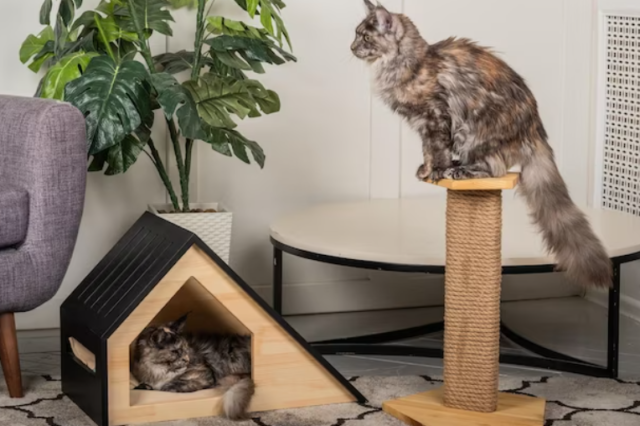Introduction: Understanding the Natural Instinct
Is your furniture falling victim to your cat’s sharp claws? Discover effective strategies and solutions to protect your prized possessions with our guide on how to stop a cat from scratching furniture. Understanding your cat’s natural instinct to scratch, we’ll provide practical techniques to redirect their behavior, offer appropriate alternatives, and safeguard your furniture. Say goodbye to scratched surfaces and create a harmonious living environment for both you and your feline friend. Take control of the scratching dilemma and enjoy a scratch-free home.

1. Provide Appropriate Scratching Surfaces
To deter your cat from scratching furniture, it’s crucial to offer alternative surfaces that fulfill its scratching needs. Invest in a sturdy cat scratching post or a scratching pad. Choose a post that is tall enough for your cat to fully stretch and provides a satisfying texture. Place the post near the furniture they typically target.
2. Make Furniture Unappealing
To discourage your cat from scratching furniture, make it less enticing. Cover the targeted areas with double-sided sticky tape or aluminum foil. Cats dislike the sticky texture or the sound of foil, deterring them from scratching there. Additionally, applying a cat-friendly deterrent spray on the furniture can discourage their scratching behavior.
3. Trim and Maintain Claws Regularly
Keeping your cat’s claws trimmed is an essential aspect of preventing furniture damage. Trim their claws regularly using cat-specific nail clippers. If you’re unsure how to do it safely, consult a veterinarian or a professional groomer. Additionally, consider providing a scratching mat infused with catnip. The scent can attract them to the mat instead of the furniture.
4. Positive Reinforcement and Distraction
When you catch your cat scratching an appropriate surface, reward them with praise, treats, or a gentle pat. Positive reinforcement helps them associate the desired behavior with rewards. If you notice them approaching the furniture, redirect their attention to their scratching post by using toys or a laser pointer. Engaging them in playtime sessions can further alleviate their scratching urges.
5. Cover Furniture with Protective Materials
If your cat continues to target specific furniture pieces, consider using protective covers. Drape a washable, slip-on cover over the areas they scratch the most. Alternatively, you can use plastic or vinyl covers that fit over the corners and edges, safeguarding your furniture from their claws.
6. Feliway Spray and Other Cat-Soothing Products
Feliway spray, which contains synthetic feline facial pheromones, can help reduce your cat’s anxiety and urge to scratch. Spray the Feliway solution on the furniture or the scratching post to create a calming environment. Additionally, there are other cat-soothing products available, such as pheromone diffusers and herbal sprays, that can help deter destructive scratching.
7. Cat Behavior Training
Consider enrolling your cat in behavior training classes or consulting a professional animal behaviorist. These experts can provide personalized advice and techniques to modify your cat’s scratching behavior effectively. By understanding the underlying reasons behind their scratching habits, you can tailor your training approach accordingly.
Homemade Spray to Stop Cats from Scratching Furniture:
To create a homemade deterrent spray, you can mix equal parts of water and apple cider vinegar in a spray bottle. Cats are generally averse to the smell of vinegar. Spray this mixture on the furniture or areas you want to protect. Remember to test the spray on a small, inconspicuous area first to ensure it doesn’t damage the material.
Best Spray to Stop Cats from Scratching Furniture:
There are several commercial sprays available that are specifically designed to deter cats from scratching furniture. Look for sprays that are safe for both cats and furniture and follow the instructions provided. These sprays often have natural scents that cats find unpleasant, effectively discouraging them from scratching.
How to Stop a Cat from Scratching Door:
To prevent your cat from scratching doors, consider the following strategies:
- Provide alternative scratching surfaces near the doors, such as scratching posts or mats.
- Apply double-sided sticky tape or aluminum foil on the door, as cats dislike the texture.
- Use cat-friendly deterrent sprays on the door to make it less appealing.
- Trim your cat’s nails regularly to reduce the potential for damage.
- Consider installing a door scratch shield or a clear plastic film to protect the door from scratching.

How to Stop a Cat from Scratching Woodwork:
To protect your woodwork from cat scratching, you can try the following:
- Provide ample scratching alternatives, such as scratching posts made of sisal or cardboard.
- Apply a pet-safe deterrent spray on the woodwork to discourage scratching.
- Cover the affected areas with temporary barriers, such as plastic sheets or aluminum foil.
- Trim your cat’s nails regularly to minimize damage.
- Consider using furniture protectors, which can be placed on the woodwork to prevent scratching.
How to Stop a Cat from Scratching Bed Base:
To prevent your cat from scratching the bed base, you can take the following measures:
- Place a cat-friendly scratching post or mat near the bed to redirect their scratching behavior.
- Cover the bed base with a protective cover or fabric that cats find unappealing to scratch.
- Apply a cat deterrent spray on the bed base to discourage scratching.
- Trim your cat’s nails regularly to minimize damage.
- Provide alternative resting spots for your cat, such as comfortable cat beds or blankets, to reduce their interest in the bed base.
How to Stop a Cat from Scratching Carpet:
To discourage your cat from scratching the carpet, try the following techniques:
- Provide alternative scratching surfaces like scratching posts covered in sisal or carpet.
- Apply a cat deterrent spray specifically designed for carpets.
- Use double-sided sticky tape or carpet runners with the rough side up to make the carpet less appealing.
- Trim your cat’s nails regularly to minimize damage.
- Redirect their attention to interactive toys or play sessions to keep them engaged and distract them from scratching the carpet.
Best Cat Scratching Post:
When choosing a scratching post, look for these features:
- Sturdy construction to withstand vigorous scratching.
- Tall enough for your cat to fully stretch their body.
- Covered in a material that cats enjoy scratching, such as sisal, cardboard, or natural wood.
- Stable and secure base to prevent tipping.
- Multiple levels or platforms for climbing and perching.
Consider options like the SmartCat Ultimate Scratching Post, PetFusion Ultimate Cat Scratcher Lounge, or the Pioneer Pet SmartCat Bootsie’s Combination Scratcher.
Cat Scratching Furniture Protectors:
To safeguard your furniture from cat scratching, you can use furniture protectors such as:
- Clear vinyl or plastic covers that can be custom-fitted to specific furniture pieces.
- Furniture-specific protectors are made of durable materials like microfiber or heavy-duty fabric.
- Sticky tape or adhesive sheets are designed to deter cats from scratching.
- Decorative slipcovers not only protect but also add a stylish touch to your furniture.
Explore options like the Sofa Scratcher Squared, Panther Armor Furniture Protectors, or the Couch Defender.

Conclusion
In conclusion, by implementing the techniques outlined in this guide, you can effectively stop your cat from scratching furniture. By understanding their natural instincts, providing appropriate alternatives, and using deterrents, you can protect your prized possessions and create a peaceful environment. Remember to be patient, and consistent, and reinforce positive behavior. With these strategies, you can successfully redirect your cat’s scratching habits and enjoy a harmonious home free from furniture damage. Say hello to scratch-free furniture and a happy coexistence with your beloved feline companion.
FAQs
Q1: Will trimming my cat's claws eliminate the need for scratching?
Trimming their claws alone won't eliminate the need to scratch, but it can significantly reduce damage to your furniture. Combine claw trimming with providing appropriate scratching surfaces for the best results.
Q2: My cat only scratches certain furniture. Why?
Cats have preferences for different materials and textures. Your cat may prefer the feel or scent of certain furniture pieces, making them more appealing for scratching.
Q3: How long does it take to train a cat to stop scratching furniture?
Training periods can vary depending on the cat's personality and previous habits. Consistent training and providing enticing alternatives can yield positive results in a matter of weeks.
Q4: Are there any health issues associated with cat scratching?
Scratching is a natural behavior, but if you notice excessive scratching, bleeding, or signs of discomfort, it's important to consult a veterinarian to rule out any underlying health issues.
Q5: Can I use claw covers to prevent furniture scratching?
Yes, claw covers can be an effective temporary solution. These soft covers are applied to your cat's claws and prevent them from causing damage while they wear them.
Q6: What is the best deterrent to keep cats from scratching furniture?
One effective deterrent is using double-sided sticky tape or aluminum foil on the furniture. Additionally, cat-friendly deterrent sprays with natural scents can help discourage scratching.
Q7: How can I protect my furniture from cat scratching?
You can protect your furniture by providing alternative scratching surfaces, using deterrent sprays, covering the furniture with protective materials, and using furniture protectors specifically designed to deter cats from scratching.
Q8: How can I stop my cat from scratching the carpet?
To stop your cat from scratching the carpet, provide alternative scratching surfaces, use deterrent sprays designed for carpets, and use double-sided sticky tape or carpet runners with the rough side up. Redirecting their attention to toys and play sessions can also help.
Q9: What should I look for in a cat scratching post?
Look for a scratching post that is sturdy, tall enough for your cat to stretch, covered in a satisfying material like sisal or cardboard, has a stable base, and offers multiple levels or platforms for climbing and perching.
Read also
- How to train a cat to use the toilet : Mastering the Art of Training
- How to Introduce a New Cat to My Home | Expert Guide
- Black Maine Coon Cat Breed Characteristics (2023)
- Fat Hairless Cat: Breed Info, Nutrition, Care, Facts, Images
- Is a Black Persian Cat the Perfect Companion for You?
- How to Choose the Perfect Modern Cat Tree for Your Home




